Abstract
The main aim of this article is to compare the financial performance of private and publicly traded companies in accordance with ownership structure and size. The analysis carried out in the article leads to the conclusion that in Poland private companies perform better than companies that are publicly traded on the Warsaw Stock Exchange (WSE). Statistically significant results are obtained for medium-sized companies. Moreover, it turns out that medium-sized enterprises operate better than large companies as far as profitability is concerned, at least in the group of private companies where results are statistically significant. The analyses conducted in the article are aimed at filling in the gap in studies comparing profitability between publicly traded and private companies.
1. Introduction
Nowadays more and more companies decide to go public, but is it really a good solution for a company and its performance? Public capital market is very often portrayed as a source of new finance. Public trading is usually seen as an important step in company’s development. However, most people including managers and companies’ owners quite often do not realise the costs connected with the decision to go public. One such cost is a significant drop in financial efficiency.
The attitude of the owner is very important in the aspect of making a decision to go public. Separating management from ownership usually leads to worsened financial performance (Jensen & Meckling, Citation1976). So the owners should be aware of the potential risks connected with the decision to go public and take care of all the necessary factors to mitigate the impact of circumstances that might negatively influence company’s financial performance.
Another very important issue that seems to be crucial while assessing the financial performance of each company is its size. It is said that size might have an impact on post-initial public offering (IPO) performance (Mikkelson, Partch, & Shah, Citation1997). In the case of large enterprises where more formalised procedures exist, the shock connected with changing the ownership structure and absorbing new capital from IPO, which can lead to the worsening of financial performance, might not be as significant as in the case of small- or medium-sized companies. So-called ‘size effect’ might also have significant influence on companies’ returns, market values, financial leverages as well as profitability (Banz, Citation1981; Roll, Citation1981; Reinganum, Citation1982; Moballeghi & Moghaddam, Citation2013).
The main aim of this article is to compare the financial performance of private and publicly traded companies. In the study it is measured mainly by return on assets (ROA) and return on equity (ROE) indicators. The study is conducted on the background of theories concerning the ownership structure and size of companies. Such theories include agency cost theory, as well as theories connected with privatisation.
It is worth pointing out that there are no studies comparing the efficiency and performance between publicly traded and private companies. Most of the studies are usually based on industry-matched public firms as a benchmark instead of private companies (Xie, Citation2010). As a result there is a literature gap as far as comparisons between private and publicly traded companies are concerned. The study is also aimed at filling this gap.
The article is based on following set of hypotheses:
| 1. | Private companies are more efficient than publicly traded ones according to their size groups.
| ||||||||||||||||
| 2. | Large companies are more efficient than medium-sized companies according to their ownership structure.
| ||||||||||||||||
Due to the fact that there are no studies of this kind, as it has been mentioned above, we try to conduct our considerations mainly in relations to IPO literature. We try to point out some changes that occur in a company’s performance after making a decision to go public and after starting to operate in the public market. The company’s decision to go public implies many changes for its everyday activities. These changes are strongly connected with the level of ownership control, costs, disclosure obligations or capital structure. All these factors might have a significant impact on financial performance of companies.
2. Literature review
Companies choose to be public or private for a variety of reasons. It should be pointed out that such a decision can have both advantages and disadvantages for the company. Amongst the advantages factors such as obtaining new finance for growth, refinancing current borrowings, loan repayment, un-levering the balance sheet, etc. can be distinguished. Moreover, being public means a dispersed shareholder base, which is strictly connected with diversification and risk sharing. In the case of public enterprise it is also much easier to obtain bank financing. Going public can be portrayed as a marketing device enhancing the company’s publicity and image. Quite often it is also connected with improvement in the morale of management and staff. On the other hand, some of the disadvantages are direct costs, underpricing, costs of information disclosure, constraints in freedom of action as far as business decisions are concerned, threat of losing control, burden of public companies’ duties or tax implications (Roell, Citation1996).
Some authors argue that using public offering means that the operating performance for companies tends to decline after going public. Such a phenomenon can be partly explained by a dilution of stock ownership, which leads to an increase in costs and therefore causes the deterioration of incentives for staff management (Jain & Kini, Citation1994). Usually, after going public, managers’ stakes fall significantly and so a decision to sell shares by insiders can be portrayed as a reason for change in the operating performance (Mikkelson et al., Citation1997). Furthermore, separating management from ownership can often adversely influence the attitude towards managing the company. This problem is widely discussed on the background of the agency theory (Jensen & Meckling, Citation1976). According to this theory the conflict between managers and owners should be less influential in private companies where, usually, the same people are both managers and owners (Francia, Porter, & Sobngwi, Citation2011).
Another supporting point of such theories is the property rights hypothesis. It assumes that in terms of ownership, performance, efficiency and profitability, private companies are better than public ones (Sarkar, Sarkar, & Bhaumik, Citation1998). Such opinions are also in accord with the theory concerning privatisation of state-owned companies. When the extensive privatisation in many Western countries was introduced, one of the main justifications supporting it was the claim that the private company should be more efficient than the public one due to a profit motive, which is portrayed as a better solution than any other form of controlling managerial staff in publicly held enterprises. On the other hand, the process of privatisation can lead to a reduction of the total efficiency of industry (De Fraja, Citation1991).
Kim, Kitsabunnarat, and Nofsinger (Citation2004) conducted a study consistent with these theories. They examined the operating performance of Thai companies which conducted public offering and found out that the performance of such firms declined significantly. They also discovered that declines in ROA in Thai companies were much higher than in the US companies, which can be explained by the fact that Thailand is still an emerging market, whereas the US is a developed economy. What is more, the authors observed that a company’s size is not an important determinant as far as performance is concerned, but ownership structure plays a key role in this matter. Companies with ‘low’ and ‘high’ levels of managerial ownership after IPO perform better compared to companies with an ‘intermediate’ level. By contrast, other researchers (e.g., Cai and Wai Citation1997) discovered, by conducting their study on the Japanese market, that there is no significant difference in the decrease in profitability between ‘low’ and ‘high’ levels of managerial ownership.
Contrary to the these theories are the results from the study conducted by Sarkar et al. (Citation1998) where the authors prove – using the Indian banking industry as an example – that there may not be significant differences in the performance of private and public companies in the case of ailing capital markets. Such a problem occurs especially in developing countries. The authors emphasise that the correlation between performance and ownership is still a matter of wide scientific discourse and there is no empirical evidence that could really help to achieve consensus in the matter. In their study they found a weak ownership effect between private and public Indian banks.
Studies conducted by Francia, Porter, and Sobgnwi (Citation2011) show that there exists a statistically significant difference in profitability between public and private companies measured by ROA. The authors examined some firms from the US trucking industry. It turned out that profitability of public companies is superior to private ones. However, one should emphasise that their further examinations showed that the structure of the ownership was not the major determinant responsible for differences in profitability.
Consistent with the studies mentioned above, there is a report written by Helwege and Packer (Citation2008). In their research carried out by means of comparative analysis of public and private companies, the authors also found out that profitability measured by ROA is not dependent on the ownership structure.
Considering the ROA ratio, in case of companies that used to be private and became public, it can be observed that their median value declines before the public offering until the end of the first year after going public (Mikkelson et al., Citation1997). Xie (Citation2010) points out while comparing the companies that went through IPO with private companies, that the former are not more profitable than the latter as far as returns on assets are concerned. The author also suggests that there is no post-issue underperformance in ROA and operating performance in case of companies that decided to go public compared to their private counterparts. However, it is worth adding that Xie’s study is conducted for insurance companies from the US which can be significant for the obtained observations.
As far as the company’s size and its performance are concerned, one should point out that Mikkelson et al. (Citation1997) argue that the performance is differentiated highly between companies of different sizes. In the case of smaller and younger companies that decided to go public, there occurs underperformance towards industry-matched private firms. But when smaller and younger firms survive for a five- or 10-year period, their performance tends to improve. By contrast in the case of bigger and ‘more established’ companies the performance is similar. However, such companies achieve high levels before the public offering and then after IPO their performance significantly declines. Their observations stay somehow in opposition to the analysis of Kim et al. (Citation2004) who claim that size does not matter as far as the company’s performance is concerned, which has been also described earlier in the article. Another very interesting remark as far as 'size effect' is concerned could be also found in some other studies dedicated to this problem. For example Banz (Citation1981) in his study points out that the 'size effect' occurs mainly in the case of very small companies whereas its strength is much lower in the case of average sized and large firms. The studies conducted by Roll (Citation1981) and Reinganum (Citation1982) are dedicated mainly to the phenomenon of abnormally high returns and risk among small companies. Moballeghi and Moghaddam (Citation2013) while analyzing the situation of selected firms at the Tehran Stock Exchange pointed out that the profitability increases as the company's size increases.
3. Methodology
The study is focused on companies that are publicly traded on the Warsaw Stock Exchange (WSE) in Poland and their private counterparts operating on the Polish market. The data are obtained from Amadeus database supplied by InfoCredit. This is a Europe-wide international database of financial reports and statements where aggregated financial, registration and structure data and many other business information are gathered.
The statistical data analysis was conducted with a help of Statistica 7 program. The companies in the study are divided into two groups: those listed on the WSE and their private counterparts, which are not publicly listed but operate on the Polish market. Additionally, another subdivision is created in accordance with the size of analysed companies, distinguishing large- and medium-sized company groups. Such divisions are aimed at identifying IPO’s influence on financial performance and efficiency between companies due to their ownership structure and size. Below we present how size evaluation is prepared:
| • | Medium-sized companies – employment: 50–249 workers, sales revenue: not exceeding 50 million euros or balance sheet total: not exceeding 43 million euros; | ||||
| • | Large companies – employment: over 250 workers, sales revenue: exceeding 50 million euros or balance sheet total: exceeding 43 million euros. | ||||
Using the methods of division described above, the following companies are selected to be studied:
| • | 96 companies listed on the WSE including:
| ||||||||||||||||
| • | 7651 private companies from Poland including:
| ||||||||||||||||
The sample is drawn in the way to keep representativeness of the study. Efficiency is measured by the application of two profitability ratios –ROA and ROE – analysed in the 2007–2011 period.
As the first step of our analysis, we examine descriptive statistics of the analysed variables. Then we carry out verification of the hypothesis of whether the profitability of companies listed on the WSE differs significantly from the profitability of companies that are not publicly traded. We do it in accordance with the size group – separately for medium-sized and large companies. Then we consider the same elaborations in accordance with the ownership group.
To test if the variables are featured by normal distribution in the analysed period we use a Lilleforse test based on Kolmogorov-Smirnov and Shapiro-Wilk test. It turns out, which is discussed in detail in our results section, that ROE and ROA indicators are not normally distributed. That is why in further analysis we use the non-parametric Mann–Whitney U test. It is a test of the null hypothesis that two populations are the same against an alternative hypothesis that a particular population is featured by different values than the other. Exceptions in the sample are the years 2007 and 2008 in the case of ROA and 2007 in the case of ROE as far as large companies publicly quoted are concerned. Observations in these years are normally distributed. Due to this fact they are excluded from further investigation.
We create dummy variables, grouping companies into two categories. The first category takes values of 0 and consists of private companies, whereas the second one takes values of 1 and consists of companies quoted on the WSE. In the study we obtain groups of 47 and 1720 units in the case of large companies and of 49 and 5931 units in the case medium-sized enterprises, which means that samples can be portrayed as the big ones. Thus we decide to conduct a Z test establishing appropriate statistical significance levels. We put underneath the following hypotheses:
H0: There are no differences in profitability amongst analysed groups.
H1: There occur differences in profitability amongst analysed groups.
4. Results
Our study is aimed at assessing the profitability between publicly traded companies and their private counterparts. Therefore, it also allows for drawing some conclusions whether to go or not to go public, which can be really useful for owners or managers of companies.
Comparing the average values of ROA variable in the group of medium-sized companies it turns out that private companies that are not listed on the WSE operate more profitably than companies that are publicly traded. In the case of ROE variable a trend is not maintained across all surveyed years. In Tables and we present descriptive statistics from this part of the study. Table contains information about medium-sized companies that are not listed on the WSE.
Table 1. Descriptive statistics of medium-sized private companies.
Table 2. Descriptive statistics of medium-sized public companies.
Table contains information about companies that are quoted on the WSE in Poland.
To find out which variables are normally distributed the Lilleforse test (based on Kolmogorov-Smirnov and Shapiro-Wilk test) was applied. Figures present the histograms of each variable (ROA and ROE) with the results of the test of normality, which in any case reject the hypothesis that both analysed variables are featured by normal distributions.
Figure 1. Histograms of ROE variables for medium-sized private companies. Source: Authors’ calculations based on data provided by Amadeus database.
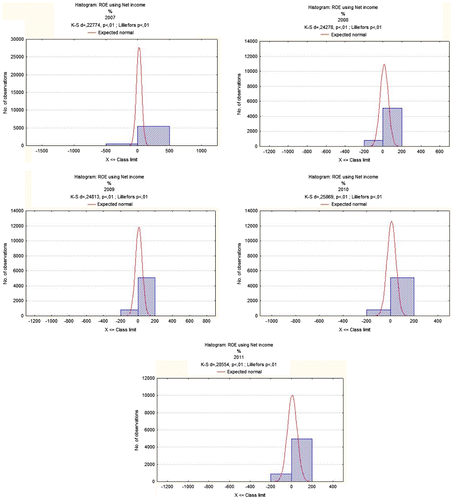
Figure 2. Histograms of ROA variables for medium-sized private companies. Source: Authors’ calculations based on data provided by Amadeus database.
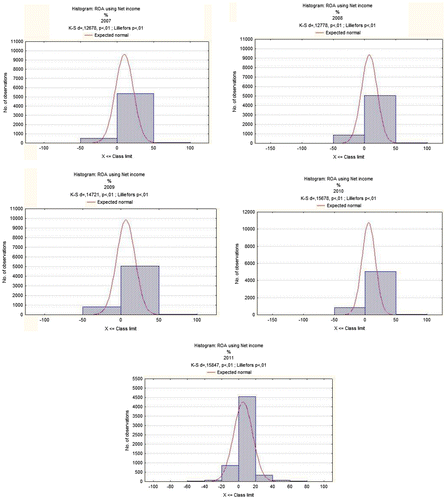
Figure 3. Histograms of ROE variables for medium-sized public companies. Source: Authors’calculations based on data provided by Amadeus database.
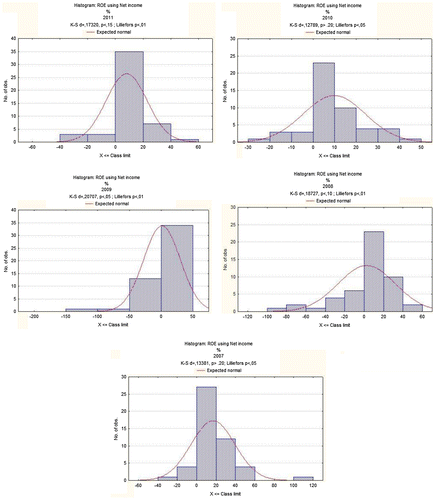
Figure 4. Histograms of ROA variables for medium-sized public companies. Source: Authors’ calculations based on data provided by Amadeus database.
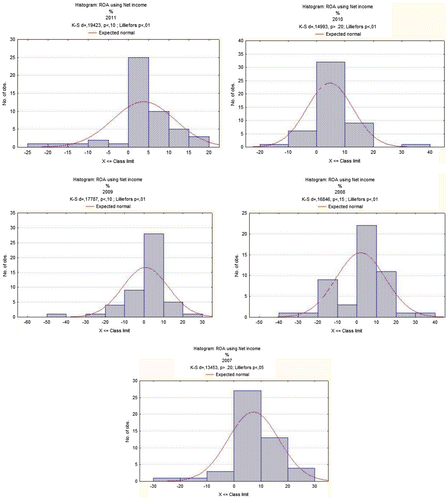
Comparing the average values of ROA and ROE variables in the group of large companies it turns out that private companies that are not quoted on the WSE operate more profitably than their publicly traded counterparts. Tables and provide descriptive statistics from this part of the study. Table contains information about large companies that are not listed on the WSE.
Table 3. Descriptive statistics of large private companies.
Table 4. Descriptive statistics of large public companies.
Table contains information about companies that are publicly traded on the WSE in Poland.
Most observations are not featured by normal distribution. Exceptions are: in the case of ROE year 2007 and in the case of ROA years 2007 and 2008. The results are obtained again with the usage of Lilleforse test based on Kolmogorov-Smirnov and Shapiro-Wilk test. Figures present the histograms of each variable (ROA and ROE) with the results of the test of normality.
Figure 5. Histograms of ROE variables for large private companies. Source: Authors’ calculations based on data provided by Amadeus database.

Figure 6. Histograms of ROA variables for large private companies. Source: Authors’ calculations based on data provided by Amadeus database.

Figure 7. Histograms of ROE variables for large public companies. Source: Authors’ calculations based on data provided by Amadeus database.
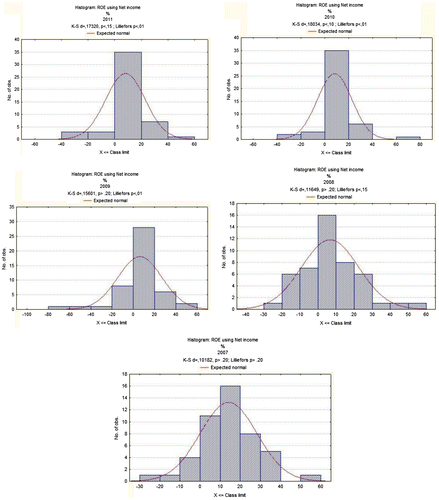
Figure 8. Histograms of ROA variables for large public companies. Source: Authors’ calculations based on data provided by Amadeus database.
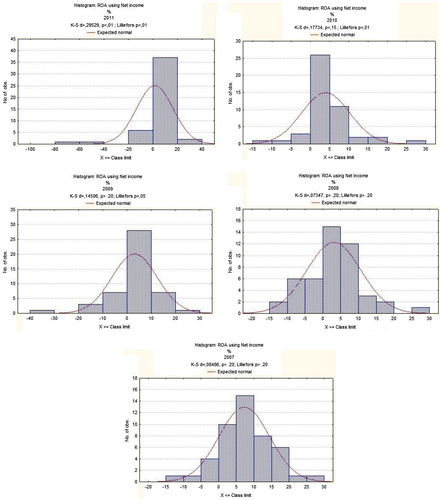
When comparing the analysed sample of companies according to the ownership structure it can be observed that in the case of private companies (see Tables and ) medium-sized companies operate better than large enterprises as far as ROA and ROE ratios are concerned.
In the case of publicly traded companies, assessment of the situation based on mean values as far as ROA and ROE ratios are concerned, is rather unclear. Taking into account the median values it can be said that in most years of the analysed period, the situation of medium-sized and large companies is quite similar. The exception is the year 2009 when large companies are featured by better ratios’ values.
In further analysis there is a verification of the hypothesis that the profitability of companies listed on the WSE differs significantly from the companies that are not publicly traded. We carry out our verification at first in accordance with the companies’ size.
I. Medium-sized companies
In the case of medium-sized companies all years of the analysed period are taken into consideration. The verification is carried out with the usage of the Mann–Whitney U test.
The sample of medium-sized companies is divided into two subsamples of companies that are or are not publicly quoted (featured respectively by 1 and 0) to verify hypotheses described in the methodology section.
Table presents some results of the Mann–Whitney U test. For the years 2008–2009 H0 is rejected in favour of H1. It is at 0.05 significance level. It means that profitability differs significantly between the groups in question. So, it can be said that financial efficiency of medium-sized companies in Poland that are not listed on the WSE is higher compared to their public counterparts.
Table 5. Results of the Mann– Whitney U test for medium-sized companies.
II. Large companies
Due to the fact that large publicly traded companies in years 2007–2008 are not featured by normal distribution, in the case of ROA indicator it is impossible to compare them with private companies featured by lack of normal distribution. The similar situation occurs in the case of ROE ratio in the year 2007. That is why, as it is pointed out in the methodology section, to verify the hypotheses we compare ROA ratios from years 2009–2011 and ROE ratios from years 2008–2011. In consistency with the methodology section again we group companies into two subsamples – enterprises that are publicly traded and the others that are not listed on the WSE (featured respectively by 1 and 0) – and we apply the Mann–Whitney U test.
Table presents the results of the Mann–Whitney U test. In the whole analysed period at the 0.05 significance level there is no reason to reject the null hypothesis as far as profitability is concerned. It means that profitability does not differ significantly in the analysed groups of companies.
Table 6. Results of the Mann–Whitney U test for large companies.
III. Private companies
While analysing the group of private companies, including medium-sized and large companies, it can be observed that significant differences occur in profitability as far as ROE and ROA ratios are concerned, in the years 2009–2011. Table presents these results.
Table 7. Results of the Mann–Whitney U test for private companies.
IV. Public companies
Table presents the results of the Mann–Whitney U test. In the whole analysed period at the 0.05 significance level there is no reason to reject the null hypothesis as far as profitability is concerned. It means that profitability does not differ significantly in the analysed groups of companies.
Table 8. Results of the Mann–Whitney U test for public companies.
5. Conclusion
The analysis carried out in the article leads to the conclusions that in Poland financial efficiency is better in the case of private companies than in the case of companies that are publicly traded on the WSE. Therefore, companies planning to go public should carefully consider all the potential benefits and possible losses associated with the IPO process before they decide to take such a step.
Statistically significant results – confirming the above thesis – are obtained in the study for the group of medium-sized companies. In the case of large enterprises there are no statistically significant differences between the groups of public and private companies.
Moreover, it turns out that medium-sized companies operate better than large companies, as far as profitability is concerned, at least in the group of private companies where the results are statistically significant.
The results are partly consistent with the presented literature regarding the performance of public and private companies.
On the one hand, as previously mentioned, many authors indicate a deteriorating financial efficiency of companies associated with going public (De Fraja, Citation1991; Jain & Kini, Citation1994; Jensen & Meckling, Citation1976; Kim et al., Citation2004; Mikkelson et al., Citation1997). Therefore, it can be concluded that private companies are featured by better financial performance than their public counterparts. In this respect, the results of our study are consistent with the results presented in the literature as far as medium-sized enterprises are concerned. Verifying this hypothesis in case of large companies does not supply clear and obvious results.
On the other hand, the results obtained in our study in the case of large enterprises indicating the possibility of lack of significant difference between the private and public companies are inconsistent with the results obtained by Sarkar et al. (Citation1998). The authors point out the possibility of the absence of statistically significant differences in profitability between private and public companies after reviewing the Indian banking sector. According to them, such phenomenon can be explained by the fact that India is an emerging economy. So, in the case of our study it is worth emphasising that Poland, according to the International Monetary Fund, is portrayed as an emerging economy as well (International Monetary Fund, Citation2014). Similar conclusions regarding the lack of differences in the profitability between public and private companies are also obtained in the study conducted by Xie (Citation2010).
As far as size is concerned, in our study there can be observed some statistically significant differences in profitability between medium-sized and large companies amongst private enterprises. It somehow corresponds to the results presented by Mikkelson et al. (Citation1997) who argue that the firm’s performance is differentiated highly between companies of different sizes. However, they are inconsistent with the results of the study conducted by Moballeghi and Moghaddam (Citation2013) who pointed out that the profitability increases as the company's size increases; in our study, the opposite situation occured: medium-sized companies operated better than large companies – and with Banz’s (Citation1981) study which suggested that “size effect” occurs mainly among small companies. In our study this could be rather observed among medium-sized and large companies. By contrast, the results obtained for public companies in our study are rather in consistency with the view that size does not matter. Such a view is presented by Kim et al. (Citation2004). Taking this into account, it can be said that situation in Poland in this matter is rather unclear.
The added value of our research is primarily the analysis of the situation in terms of financial efficiency of public and private companies on the Polish capital market. In the article, mainly descriptive methods were used. However, we believe that our study can be portrayed as a first step towards further economic modeling resulting in explanatory model which is portrayed as the last step of scientific research process (Kuc, Citation2012): of the impact of public offering on company's financial performance in Poland. The analyses are also conducted in accordance with the size groups. As far as we know, this type of study has not yet appeared in the international scientific literature. Moreover, our study goes someway to filling the gap, pointed out by Xie (Citation2010) and described earlier in the article, concerning the lack of comparative studies on financial performance of public and private companies – understood as the companies listed on the stock exchange. With this in mind, we believe that the findings presented in our study make an important contribution to the literature on the financial performance of public and private companies.
Disclosure statement
No potential conflict of interest was reported by the authors.
References
- Banz, R. W. (1981). The relationship between return and market value of common stocks. Journal of Financial Economics, 9, 3–18.
- Cai, J., & Wai, K. C. J. (1997). The investment and operating performance of Japanese initial public offerings. Pacific-Basin Finance Journal, 5, 389–417. 10.1016/S0927-538X(97)00021-8
- De Fraja, G. (1991). Efficiency and privatization in imperfectly competitive industries. The Journal of Industrial Economics, 39, 311–321. 10.2307/2098522
- Francia, A. J., Porter, M. C., & Sobgnwi, Ch. K. (2011). Ownership structure and financial performance in the trucking industry. Academy of Accounting and Financial Studies Journal, 15, 111–122.
- Helwege, J., & Packer, F. (2008). Private matters. BIS Working Papers, no. 266, Bank for International Settlements.
- International Monetary Fund. (2014). World economic outlook – Recovery strengthens, remains uneven. Retrieved April, 23 2014, from http://www.imf.org/external/pubs/ft/weo/2014/01/pdf/text.pdf.
- Jain, B. A., & Kini, O. (1994). The Post-issue operating performance of ipo firms. The Journal of Finance, 49, 1699–1726.10.1111/j.1540-6261.1994.tb04778.x
- Jensen, M., & Meckling, W. (1976). Theory of the firm: Managerial behavior, agency costs and ownership structure. Journal of Financial Economics, 3, 305–360.
- Kim, K. A., Kitsabunnarat, P., & Nofsinger, J. R. (2004). Ownership and operating performance in an emerging market: Evidence from Thai IPO firms. Journal of Corporate Finance, 10, 355–381. 10.1016/S0929-1199(02)00019-6
- Kuc, B. R. (2012). Funkcje nauki. Wstęp do metodologii. Nauka nie jest grą. Warszawa: Wydawnictwo Menedżerskie PTM, 2012.
- Mikkelson, W. H., Partch, M. M., & Shah, K. (1997). Ownership and operating performance of companies that go public. Journal of Financial Economics, 44, 281–307. 10.1016/S0304-405X(97)00006-8
- Moballeghi, M., & Moghaddam, F. G. (2013). Firm size, beta and financial leverage: Stock exchange in Iran. SCMS Journal of Indian Management, 10, 40–47.
- Reinganum, M. R. (1982). A direct test of roll's conjecture on the firm size effect. Journal of Finance, 37, 27–35.
- Roell, A. (1996). The decision to go public: An overview. European Economic Review, 40, 1071–1081. 10.1016/0014-2921(95)00114-X
- Roll, R. (1981). A possible explanation of the small firm effect. Journal of Finance, 36, 879–888.
- Sarkar, J., Sarkar, S., & Bhaumik, S. K. (1998). Does ownership always matter?—Evidence from the Indian banking industry. Journal of Comparative Economics, 26, 262–281.10.1006/jcec.1998.1516
- Xie, X. (2010). Are publicly held firms less efficient? Evidence from the US property-liability insurance industry. Journal of Banking & Finance, 34, 1549–1563.
